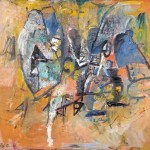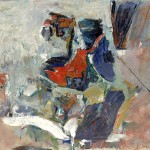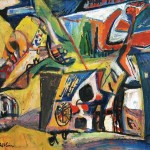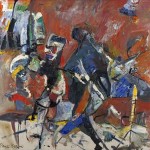Paul Burlin

Originally named Isadore Berlin, Paul Burlin was born in New York on September 10, 1886. He changed his name from Isadore Berlin to Harry Paul Burlin shortly after leaving home at the age of 16. By the time he turned thirty, he had dropped the name Harry altogether. Many believe he changed his name to escape a tormented childhood. He refused to speak about his childhood or his family and severed his relationship with them entirely.
Burlin studied painting part-time at the Art Students League and at the National Academy of Art in New York from 1900 to 1912. He traveled to Santa Fe, New Mexico 1910 and the paintings from that trip were shown in New York in 1911. The acclaim these paintings generated led to his being invited to participate in the infamous 1913 Armory Show, which was the first Modern art exhibition ever to be held in the United States. He subsequently moved to Sante Fe in 1913 and lived there until 1920. He continued to display his work in New York galleries and the painting he did of Pueblo culture and desert landscapes sold very well.
Click here to continue reading this biography
Grief stricken from his wife’s death, Paul Burlin continued to live in Europe for ten years. While living in Europe he exhibited his work in New York, and in Paris. He became acquainted with and influenced by the European abstract artists of that era and his paintings became increasingly abstract until he abandoned figurative painting altogether. During that time he met his second wife Margot Koop. They were married in 1924 and had a child together in 1927. Three of his paintings were displayed in the Museum of Modern Art’s Exhibition of Painting and Sculpture by Living Americans in 1930. He moved back to the U.S. with his family in 1932 and settled in New York City.
During the 1950’s, Paul Burlin began to lose the vision in both of his eyes. He received several cornea implants and his vision would come and go during the course of 10 years. He would continue to paint even at times when he was considered to be legally blind. During a brief respite from his blindness he painted “The Series of Nine” during the final months of his life. He died in New York on March 13, 1969. His final series of paintings were displayed at the New York Museum of Modern Art (MOMA) in 1971.
- Photograph of Paul Burlin
- Pueblo Girl – 1918
- Heads or Tails – 1947
- I – 1953
- Inner Space – 1955
- The Pigeon Does Not Fly – 1957
- White Phantom – 1961
- A – 1961
- Untitled (New Life)
- Migration










